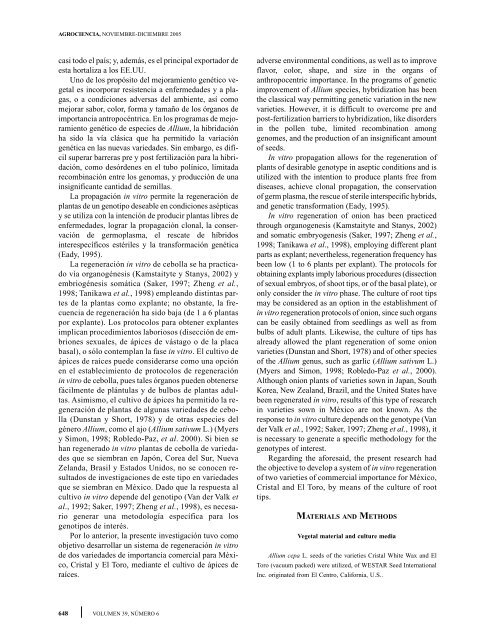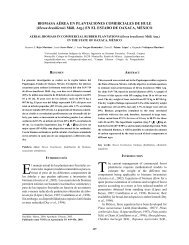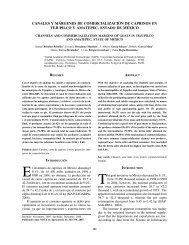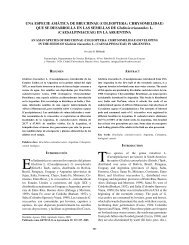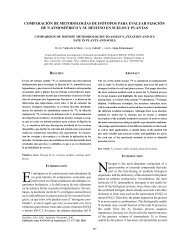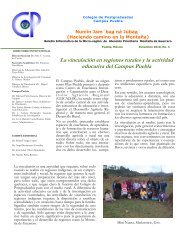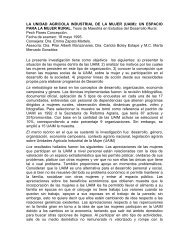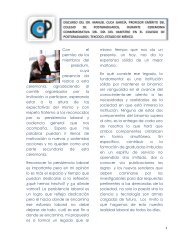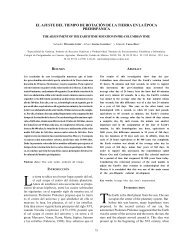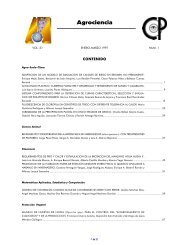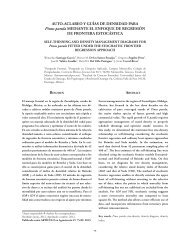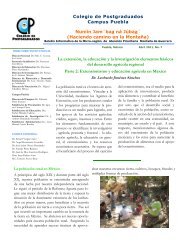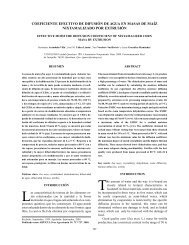04-161 (Regeneración in vitro) - Colegio de Postgraduados
04-161 (Regeneración in vitro) - Colegio de Postgraduados
04-161 (Regeneración in vitro) - Colegio de Postgraduados
You also want an ePaper? Increase the reach of your titles
YUMPU automatically turns print PDFs into web optimized ePapers that Google loves.
AGROCIENCIA, NOVIEMBRE-DICIEMBRE 2005<br />
casi todo el país; y, a<strong>de</strong>más, es el pr<strong>in</strong>cipal exportador <strong>de</strong><br />
esta hortaliza a los EE.UU.<br />
Uno <strong>de</strong> los propósito <strong>de</strong>l mejoramiento genético vegetal<br />
es <strong>in</strong>corporar resistencia a enfermeda<strong>de</strong>s y a plagas,<br />
o a condiciones adversas <strong>de</strong>l ambiente, así como<br />
mejorar sabor, color, forma y tamaño <strong>de</strong> los órganos <strong>de</strong><br />
importancia antropocéntrica. En los programas <strong>de</strong> mejoramiento<br />
genético <strong>de</strong> especies <strong>de</strong> Allium, la hibridación<br />
ha sido la vía clásica que ha permitido la variación<br />
genética en las nuevas varieda<strong>de</strong>s. S<strong>in</strong> embargo, es difícil<br />
superar barreras pre y post fertilización para la hibridación,<br />
como <strong>de</strong>sór<strong>de</strong>nes en el tubo polínico, limitada<br />
recomb<strong>in</strong>ación entre los genomas, y producción <strong>de</strong> una<br />
<strong>in</strong>significante cantidad <strong>de</strong> semillas.<br />
La propagación <strong>in</strong> <strong>vitro</strong> permite la regeneración <strong>de</strong><br />
plantas <strong>de</strong> un genotipo <strong>de</strong>seable en condiciones asépticas<br />
y se utiliza con la <strong>in</strong>tención <strong>de</strong> producir plantas libres <strong>de</strong><br />
enfermeda<strong>de</strong>s, lograr la propagación clonal, la conservación<br />
<strong>de</strong> germoplasma, el rescate <strong>de</strong> híbridos<br />
<strong>in</strong>terespecíficos estériles y la transformación genética<br />
(Eady, 1995).<br />
La regeneración <strong>in</strong> <strong>vitro</strong> <strong>de</strong> cebolla se ha practicado<br />
vía organogénesis (Kamstaityte y Stanys, 2002) y<br />
embriogénesis somática (Saker, 1997; Zheng et al.,<br />
1998; Tanikawa et al., 1998) empleando dist<strong>in</strong>tas partes<br />
<strong>de</strong> la plantas como explante; no obstante, la frecuencia<br />
<strong>de</strong> regeneración ha sido baja (<strong>de</strong> 1 a 6 plantas<br />
por explante). Los protocolos para obtener explantes<br />
implican procedimientos laboriosos (disección <strong>de</strong> embriones<br />
sexuales, <strong>de</strong> ápices <strong>de</strong> vástago o <strong>de</strong> la placa<br />
basal), o sólo contemplan la fase <strong>in</strong> <strong>vitro</strong>. El cultivo <strong>de</strong><br />
ápices <strong>de</strong> raíces pue<strong>de</strong> consi<strong>de</strong>rarse como una opción<br />
en el establecimiento <strong>de</strong> protocolos <strong>de</strong> regeneración<br />
<strong>in</strong> <strong>vitro</strong> <strong>de</strong> cebolla, pues tales órganos pue<strong>de</strong>n obtenerse<br />
fácilmente <strong>de</strong> plántulas y <strong>de</strong> bulbos <strong>de</strong> plantas adultas.<br />
Asimismo, el cultivo <strong>de</strong> ápices ha permitido la regeneración<br />
<strong>de</strong> plantas <strong>de</strong> algunas varieda<strong>de</strong>s <strong>de</strong> cebolla<br />
(Dunstan y Short, 1978) y <strong>de</strong> otras especies <strong>de</strong>l<br />
género Allium, como el ajo (Allium sativum L.) (Myers<br />
y Simon, 1998; Robledo-Paz, et al. 2000). Si bien se<br />
han regenerado <strong>in</strong> <strong>vitro</strong> plantas <strong>de</strong> cebolla <strong>de</strong> varieda<strong>de</strong>s<br />
que se siembran en Japón, Corea <strong>de</strong>l Sur, Nueva<br />
Zelanda, Brasil y Estados Unidos, no se conocen resultados<br />
<strong>de</strong> <strong>in</strong>vestigaciones <strong>de</strong> este tipo en varieda<strong>de</strong>s<br />
que se siembran en México. Dado que la respuesta al<br />
cultivo <strong>in</strong> <strong>vitro</strong> <strong>de</strong>pen<strong>de</strong> <strong>de</strong>l genotipo (Van <strong>de</strong>r Valk et<br />
al., 1992; Saker, 1997; Zheng et al., 1998), es necesario<br />
generar una metodología específica para los<br />
genotipos <strong>de</strong> <strong>in</strong>terés.<br />
Por lo anterior, la presente <strong>in</strong>vestigación tuvo como<br />
objetivo <strong>de</strong>sarrollar un sistema <strong>de</strong> regeneración <strong>in</strong> <strong>vitro</strong><br />
<strong>de</strong> dos varieda<strong>de</strong>s <strong>de</strong> importancia comercial para México,<br />
Cristal y El Toro, mediante el cultivo <strong>de</strong> ápices <strong>de</strong><br />
raíces.<br />
648 VOLUMEN 39, NÚMERO 6<br />
adverse environmental conditions, as well as to improve<br />
flavor, color, shape, and size <strong>in</strong> the organs of<br />
anthropocentric importance. In the programs of genetic<br />
improvement of Allium species, hybridization has been<br />
the classical way permitt<strong>in</strong>g genetic variation <strong>in</strong> the new<br />
varieties. However, it is difficult to overcome pre and<br />
post-fertilization barriers to hybridization, like disor<strong>de</strong>rs<br />
<strong>in</strong> the pollen tube, limited recomb<strong>in</strong>ation among<br />
genomes, and the production of an <strong>in</strong>significant amount<br />
of seeds.<br />
In <strong>vitro</strong> propagation allows for the regeneration of<br />
plants of <strong>de</strong>sirable genotype <strong>in</strong> aseptic conditions and is<br />
utilized with the <strong>in</strong>tention to produce plants free from<br />
diseases, achieve clonal propagation, the conservation<br />
of germ plasma, the rescue of sterile <strong>in</strong>terspecific hybrids,<br />
and genetic transformation (Eady, 1995).<br />
In <strong>vitro</strong> regeneration of onion has been practiced<br />
through organogenesis (Kamstaityte and Stanys, 2002)<br />
and somatic embryogenesis (Saker, 1997; Zheng et al.,<br />
1998; Tanikawa et al., 1998), employ<strong>in</strong>g different plant<br />
parts as explant; nevertheless, regeneration frequency has<br />
been low (1 to 6 plants per explant). The protocols for<br />
obta<strong>in</strong><strong>in</strong>g explants imply laborious procedures (dissection<br />
of sexual embryos, of shoot tips, or of the basal plate), or<br />
only consi<strong>de</strong>r the <strong>in</strong> <strong>vitro</strong> phase. The culture of root tips<br />
may be consi<strong>de</strong>red as an option <strong>in</strong> the establishment of<br />
<strong>in</strong> <strong>vitro</strong> regeneration protocols of onion, s<strong>in</strong>ce such organs<br />
can be easily obta<strong>in</strong>ed from seedl<strong>in</strong>gs as well as from<br />
bulbs of adult plants. Likewise, the culture of tips has<br />
already allowed the plant regeneration of some onion<br />
varieties (Dunstan and Short, 1978) and of other species<br />
of the Allium genus, such as garlic (Allium sativum L.)<br />
(Myers and Simon, 1998; Robledo-Paz et al., 2000).<br />
Although onion plants of varieties sown <strong>in</strong> Japan, South<br />
Korea, New Zealand, Brazil, and the United States have<br />
been regenerated <strong>in</strong> <strong>vitro</strong>, results of this type of research<br />
<strong>in</strong> varieties sown <strong>in</strong> México are not known. As the<br />
response to <strong>in</strong> <strong>vitro</strong> culture <strong>de</strong>pends on the genotype (Van<br />
<strong>de</strong>r Valk et al., 1992; Saker, 1997; Zheng et al., 1998), it<br />
is necessary to generate a specific methodology for the<br />
genotypes of <strong>in</strong>terest.<br />
Regard<strong>in</strong>g the aforesaid, the present research had<br />
the objective to <strong>de</strong>velop a system of <strong>in</strong> <strong>vitro</strong> regeneration<br />
of two varieties of commercial importance for México,<br />
Cristal and El Toro, by means of the culture of root<br />
tips.<br />
MATERIALS AND METHODS<br />
Vegetal material and culture media<br />
Allium cepa L. seeds of the varieties Cristal White Wax and El<br />
Toro (vacuum packed) were utilized, of WESTAR Seed International<br />
Inc. orig<strong>in</strong>ated from El Centro, California, U.S..


